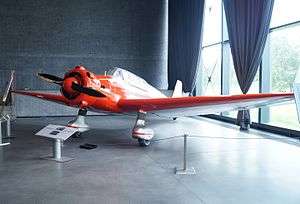LWD Zuch
The Zuch was a Polish aerobatics and trainer aircraft, built in 1948 in the LWD bureau and produced in a small series.
| LWD Zuch | |
|---|---|
 | |
| Role | Trainer/aerobatics aircraft |
| Manufacturer | Lotnicze Warsztaty Doświadczalne |
| First flight | 1 September 1948 |
| Introduction | 1949 |
| Retired | 1963 |
| Primary user | Poland |
| Produced | 1948-1950 |
| Number built | 7 |
| Developed from | LWD Junak-1 |
Design and development
The aircraft was a development of a military and civilian trainer plane LWD Junak-1, meant as a civilian aerobatics and trainer plane for the Polish Aero Club. It was designed in the Lotnicze Warsztaty Doświadczalne (LWD - Aircraft Experimental Workshops), a main designer was Tadeusz Sołtyk. The design was similar to Junak-1, the main difference was en engine. Unlike Junak, its fixed landing gear, in massive covers, was lacking struts. It was also fitted with split flaps and had slightly enlarged rudder (similar improvements were later adapted in Junak-2).
Description
Mixed construction (steel and wood) low-wing monoplane, conventional in layout. Fuselage of a steel frame, covered with canvas, in front with metal sheet. Two-spar wings of wooden construction and trapezoid shape, canvas and plywood covered, fitted with split flaps. Cockpit with two seats in tandem, under a multi-part closed canopy. Conventional fixed landing gear with a tail wheel, main gear in massive covers. Engine in front: Zuch-1: 6-cylinder inline engine Walter Minor 6-III (118 kW / 160 hp), Zuch-2: 7-cylinder radial engine Bramo Sh 14 (118 kW / 160 hp) with a ring cover with individual cowls for cylinders. Two-blade wooden propeller.
The first variant Zuch-1 was powered by the Czechoslovak 160 hp Walter Minor 6-III inline engine in a long, slant nose. The prototype flew first on September 1, 1948. The design was quite successful and fit to aerobatics, but it did not enter production because of decision not to produce Walter Minor engines in Poland. The prototype served in aero clubs from 1950 until end of 1955, with markings SP-BAD.
The second prototype Zuch-2 was fitted with a radial engine Bramo Sh 14. It was flown on April 1, 1949 and carried markings SP-BAG. Because of increased drag, maximum speed was lower - 222 km/h comparing to 244 km/h of Zuch-1. Because there were several Sh 14 engines available, left in the country by retreating Germans, the LWD next built a short series of 5 Zuch-2s in 1950. They carried markings SP-BAL - SP-BAP and served in aero clubs until 1955, except SP-BAM, which served until 1963.
Survivors
- Zuch-1 (SP-BAD)
- Preserved in the Polish Aviation Museum in Kraków (damaged and disassembled).
- Zuch-2 (SP-BAM)
- Preserved in the Polish Aviation Museum in Kraków (disassembled).
- Zuch-2 (SP-BAO)
- Preserved in the Polish Aviation Museum in Kraków (incomplete and disassembled).
Specifications (Zuch 2)
Data from
General characteristics
- Crew: 2
- Length: 7.61 m (25 ft 0 in)
- Wingspan: 10 m (32 ft 10 in)
- Height: 2.1 m (6 ft 11 in)
- Wing area: 17.5 m2 (188 sq ft)
- Powerplant: 1 × Bramo Sh 14 7-cylinder air-cooled radial piston engine, 120 kW (160 hp)
- Propellers: 2-bladed propeller
Performance
- Maximum speed: 222 km/h (138 mph, 120 kn)
- Cruise speed: 181 km/h (112 mph, 98 kn)
- Range: 1,160 km (720 mi, 630 nmi)
- Service ceiling: 4,750 m (15,580 ft)
- Rate of climb: 36 m/s (7,100 ft/min)
- Wing loading: 58.3 kg/m2 (11.9 lb/sq ft)
See also
Related development
Aircraft of comparable role, configuration and era
- Zlin Z-26 Trener
References
- Kempski, Benedykt, Samolot szkolno-treningowy Junak, Typy Broni i Uzbrojenia #110, Wydawnictwo MON, Warsaw 1986, ISBN 83-11-07341-4 (in Polish)